What is Epistasis?
Epistasis refers to the phenomenon where the expression of one gene masks or suppresses the phenotypic effects of another gene. This interaction occurs between non-allelic genes, meaning that it involves genes located at different loci rather than different alleles of the same gene.
Historically, Mendelian genetics proposed that traits were controlled by single genes with dominant and recessive alleles. This model, however, proved insufficient to explain the complexities of inheritance observed in many traits. Mendelian ratios, such as 3:1 in monohybrid crosses and 9:3:3:1 in dihybrid crosses, did not always fit observed outcomes, revealing the limitations of Mendel’s initial framework.
The concept of gene interaction was further developed by William Bateson and R.C. Punnett, who introduced the “Factor Hypothesis.” This hypothesis posits that certain traits result from the interaction of multiple genes, challenging the simplistic one-gene, one-trait model. Gene interactions can occur between alleles of the same gene (intragenic interaction) or between different genes (intergenic interaction).
Intragenic interaction involves interactions between different alleles of a single gene, influencing trait expression within that gene’s framework. On the other hand, intergenic interaction involves interactions between genes located on the same or different chromosomes, where the combined effect of multiple gene products determines a specific trait.
William Bateson coined the term “epistatic” in 1909 to describe situations where one mutation masks the effects of other mutations. Later, R.A. Fisher expanded on this concept with the term “epistasis,” emphasizing the statistical deviation from the additive effects of multiple loci.
Epistasis manifests in various forms, including:
- Interaction Between Loci: Two or more loci combine to produce novel phenotypes.
- Masking Effect: An allele at one locus hides the phenotypic effects of alleles at other loci.
- Altering Effects: An allele at one locus modifies the effects of alleles at other loci.
Therefore, epistasis highlights the complexity of genetic interactions and their impact on phenotype expression. It underscores that gene expression is not an isolated event but rather a coordinated process influenced by multiple genetic factors.
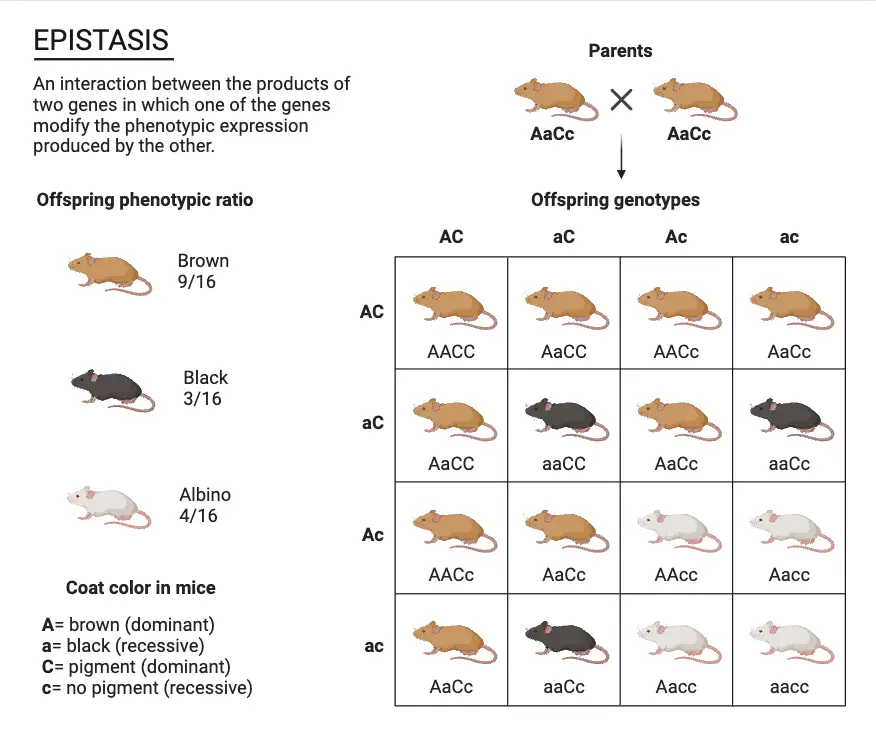
Definition of Epistasis
Epistasis is the genetic interaction where the expression of one gene masks or suppresses the phenotypic effects of another gene, involving non-allelic genes.
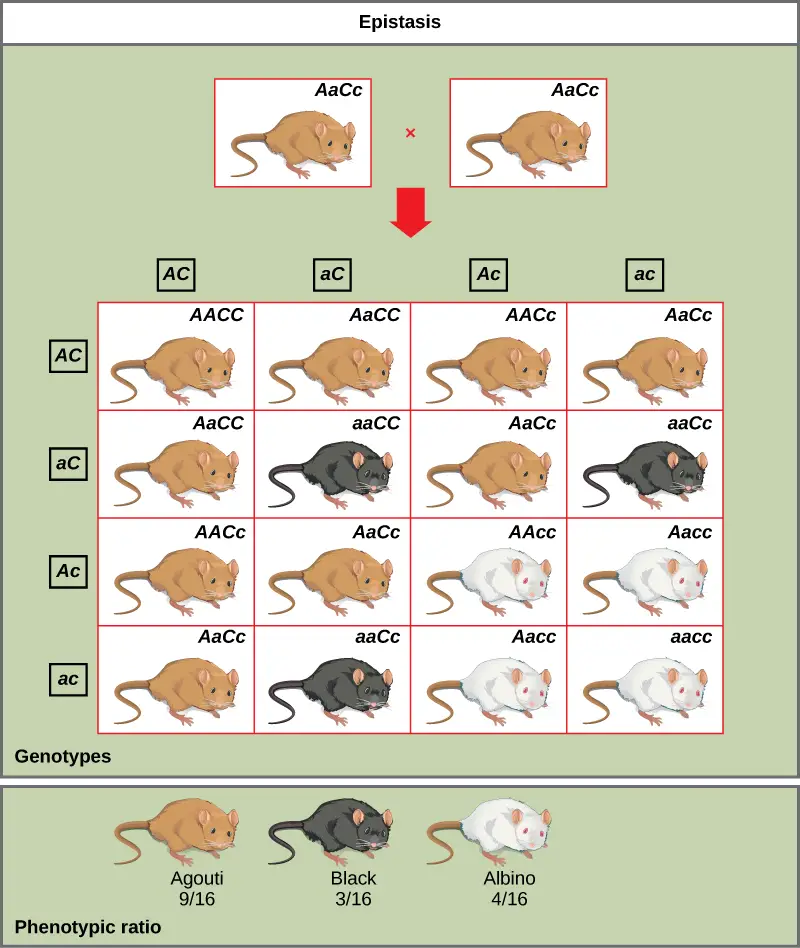
Types of Epistasis
Epistasis describes various interactions between genes where the expression of one gene affects the phenotypic outcome of another gene. Here are the primary types of epistasis:
- Dominant Epistasis
- Definition: A dominant allele at one locus masks the phenotypic expression of alleles at another locus, whether they are dominant or recessive.
- Example: In summer squash (Cucurbita pepo), the presence of a dominant allele (W) for white fruit color masks the effects of both dominant and recessive alleles at a different locus that control yellow and green colors. This interaction results in a modified F2 ratio of 12:3:1 instead of the expected 9:3:3:1.
- Dominant Inhibitory Epistasis
- Definition: A dominant allele at one locus inhibits the expression of both dominant and recessive alleles at a second locus.
- Example: In rice, the dominant allele (I) for green color inhibits the expression of the dominant allele (P) for purple color. This results in a modified F2 ratio of 13:3, where the presence of allele I produces green rice, while its absence allows for the expression of the purple color if allele P is present.
- Recessive Epistasis
- Definition: Recessive alleles at one locus hide the phenotypic effects of alleles at another locus, regardless of whether they are dominant or recessive.
- Example: In Labrador retrievers, the presence of two recessive alleles (ee) at one locus masks the expression of both dominant and recessive alleles at another locus responsible for coat color, changing the expected F2 ratio from 9:3:3:1 to 9:3:4.
- Duplicate Dominant Epistasis
- Definition: The presence of a dominant allele at either of two loci conceals the expression of complementary recessive alleles at both loci.
- Example: In rice, the presence of a dominant allele at either of two loci results in the presence of an awn character. The F2 ratio changes from the expected 9:3:3:1 to 15:1, where either dominant allele A or B suffices for the development of awns.
- Duplicate Recessive Epistasis
- Definition: Recessive alleles at either of two loci mask the expression of dominant alleles at both loci, requiring both loci to be dominant for the phenotype to be expressed.
- Example: In sweet peas, two recessive alleles at either of two loci produce a white flower, changing the expected F2 ratio from 9:3:3:1 to 9:7. Both dominant alleles (A and B) are required together to produce the purple flower color.
- Polymeric Epistasis
- Definition: Dominant alleles at two or more loci work together to produce a phenotype that is more pronounced than the effect of individual alleles.
- Example: In summer squash, the interaction of dominant alleles at two loci results in a range of fruit shapes. This leads to an F2 ratio of 9:6:1, where the presence of dominant alleles results in disc-shaped fruit, while different combinations produce spherical and long shapes.
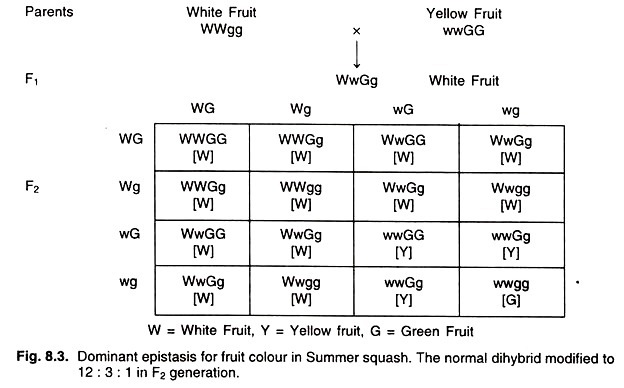
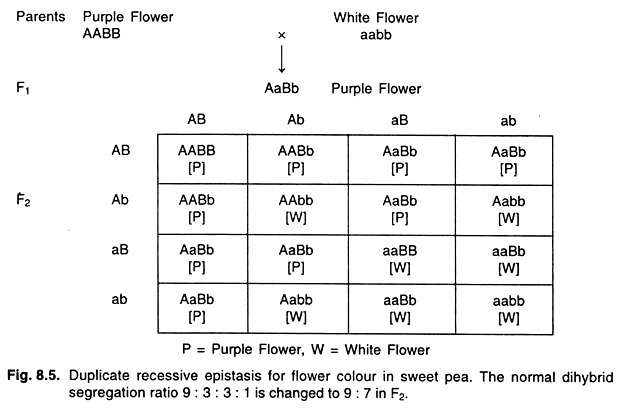
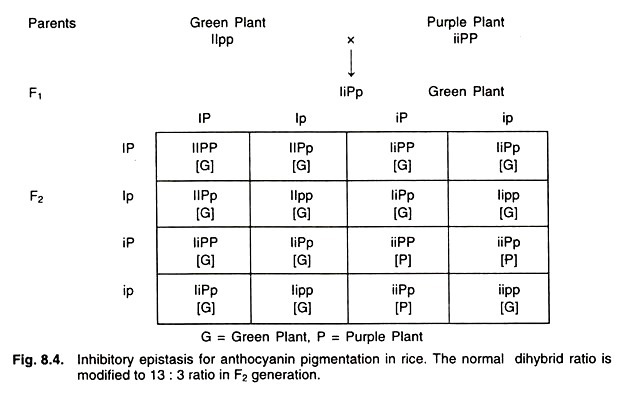
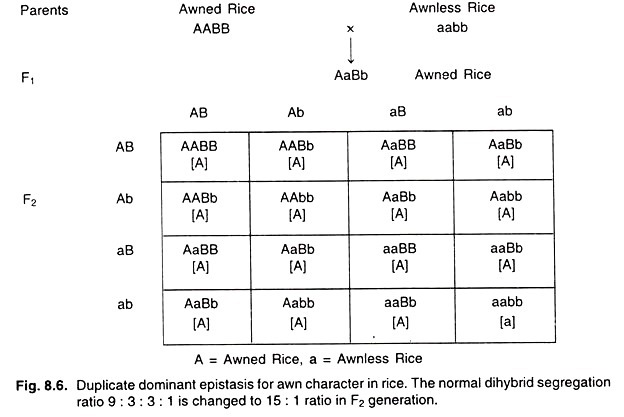
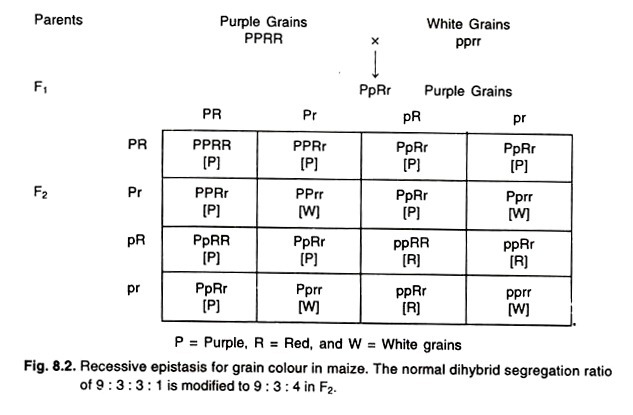
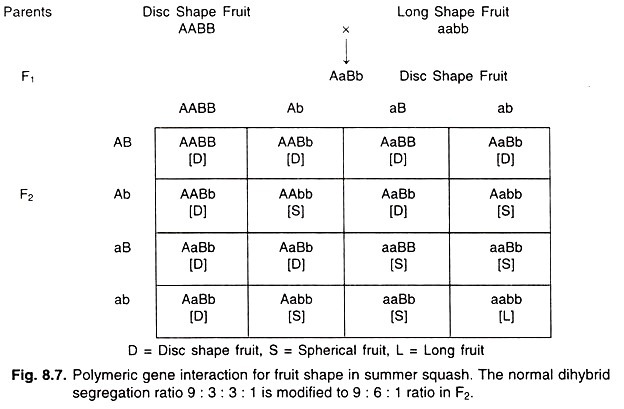
Different classes of Epistasis
Epistasis, the interaction between genes where one gene influences the expression of another, can be categorized into various classes based on different criteria. These classifications help in understanding the diverse ways in which genes interact and affect phenotypic outcomes.
- Based on Outcome
- Positive Epistasis: This occurs when the effect of a mutation results in a phenotype that is more favorable or fitter than expected. The presence of the epistatic gene enhances the overall fitness or functionality in a given genetic background.
- Negative Epistasis: Conversely, negative epistasis arises when the mutation results in a phenotype that is less fit or more detrimental than expected. Here, the epistatic gene leads to a reduction in fitness or functionality.
- Based on Strength and Direction of Mutation
- Magnitude Epistasis: This type involves changes in the effect size of a mutation depending on the genetic background. The magnitude of the phenotypic effect of the mutation varies, demonstrating how different backgrounds can alter the intensity of the mutation’s impact.
- Sign Epistasis: Sign epistasis occurs when the direction of the mutation’s effect (e.g., beneficial or harmful) changes depending on the genetic background. Essentially, the same mutation can have different phenotypic outcomes in different genetic contexts.
- Based on Number of Mutations
- Pairwise Epistasis: This form involves interactions between two mutations. It focuses on how two specific mutations influence each other’s effects on the phenotype.
- Higher-Order Epistasis: When more than two mutations interact, the epistatic interaction is termed higher-order. This class addresses more complex scenarios where multiple mutations collectively affect the phenotype.
- Based on Specificity
- Specific Epistasis: In specific epistasis, one mutation modulates the effects of a limited number of other mutations. This indicates a targeted interaction between specific genetic factors.
- Non-Specific Epistasis: In contrast, non-specific epistasis involves a mutation that affects the phenotypic outcomes of a broad range of other mutations. This type reflects a more generalized influence on multiple genetic interactions.
- Based on Measurement of Interaction
- Background-Relative Epistasis: This measurement refers to the assessment of genetic interactions within a specific genetic background. It evaluates how interactions influence phenotypic outcomes relative to a defined genetic context.
- Background-Averaged Epistasis: This approach involves averaging the effects of genetic interactions across various genetic backgrounds. It provides a generalized view of how interactions play out across different genetic settings.
Epistasis Ratio
Epistasis involves the interaction between genes where one gene affects or masks the expression of another gene. These interactions can result in specific phenotypic ratios that deviate from Mendelian expectations. The ratios observed in epistatic interactions include:
- Dominant Epistasis (12:3:1)
- Mechanism: A dominant allele at one gene locus masks the expression of alleles at another locus.
- Example: In summer squash (Cucurbita pepo), the presence of a dominant allele for white color (W) masks the effects of both yellow and green alleles. This results in a phenotypic ratio of 12 white: 3 yellow: 1 green in the F2 generation.
- Recessive Epistasis (9:3:4)
- Mechanism: A recessive allele at one gene locus suppresses the expression of alleles at another locus.
- Example: In Labrador retrievers, the coat color is influenced by two loci. A recessive allele at one locus can mask the effects of another gene, leading to a phenotypic ratio of 9 black: 3 chocolate: 4 yellow.
- Duplicate Recessive Epistasis (9:7)
- Mechanism: Two recessive alleles, one from each of two loci, are required to produce a specific phenotype.
- Example: In sweet peas (Lathyrus odoratus), the presence of recessive alleles at either of two loci results in a white flower, whereas dominant alleles at both loci produce purple flowers. This results in a ratio of 9 purple: 7 white.
- Complementary Epistasis (9:7)
- Mechanism: At least one dominant allele from each of two genes is required for the expression of a specific phenotype. The presence of either dominant or recessive alleles at both loci results in different phenotypes.
- Example: In the color development of certain flowers, the presence of at least one dominant allele at each locus is necessary for the appearance of the desired color. If either gene is homozygous recessive, the phenotype differs.
- Dominant Inhibitory Epistasis (12:3:1)
- Mechanism: A dominant allele at one locus inhibits the expression of another gene, regardless of its dominance or recessiveness.
- Example: In rice, the presence of a dominant inhibitory allele prevents the expression of the color-producing genes, resulting in a phenotypic ratio of 12 green: 3 purple: 1 other color (if applicable).
Causes of Epistasis
Epistasis arises when one gene affects or masks the expression of another gene. This phenomenon can result from various genetic mechanisms, including:
- Gene Regulation
- Mechanism: Genes that regulate the expression of other genes may experience mutations that alter their regulatory function.
- Impact: Such disruptions can modify or suppress the expression of downstream genes, leading to epistatic interactions. For example, a mutation in a transcription factor gene may prevent the activation of a target gene, masking its effects.
- Enzyme Function
- Mechanism: Genes encoding enzymes in metabolic pathways can be mutated, resulting in non-functional or inefficient enzymes.
- Impact: If an enzyme is unable to catalyze a reaction effectively, it can block the entire pathway. This blockage affects the production of intermediate compounds that may, in turn, influence the expression of other genes, thus creating epistatic interactions.
- Protein-Protein Interactions
- Mechanism: Mutations that affect protein-protein interactions can disrupt normal cellular functions.
- Impact: Proteins often function through interactions with other proteins. Mutations that impair these interactions can lead to the masking or alteration of phenotypic effects of genes coding for interacting proteins, resulting in epistasis.
- Signalling Pathways
- Mechanism: Mutations in genes that encode proteins involved in cellular signalling pathways can disrupt signal transmission.
- Impact: These disruptions can prevent proper activation or inhibition of downstream targets, affecting gene expression and leading to epistatic effects. For instance, a mutation in a signalling pathway gene may block the pathway’s activation, altering the expected phenotypic outcome.
- Developmental Pathways
- Mechanism: Genes that are crucial for developmental processes can experience mutations that alter developmental gene expression sequences.
- Impact: Such mutations can disrupt the normal sequence of developmental events, which may result in epistatic interactions where the expression of certain traits is masked or modified by the developmental changes.
- Dosage Compensation
- Mechanism: Dosage compensation mechanisms balance gene expression between sexes, especially for sex-linked genes.
- Impact: Disruptions in these mechanisms can lead to differences in gene expression between sexes, which can manifest as epistatic effects, where the expression of certain traits differs due to dosage imbalances.
Genetic and Molecular Causes of Epistasis
Epistasis arises from intricate interactions among genes, and understanding its genetic and molecular bases is crucial for comprehending how gene expression is regulated. The following points detail the various genetic and molecular causes of epistasis:
1. Additivity
- Definition: Additivity occurs when multiple genes or gene products collectively contribute to a particular phenotypic outcome. Each gene or product works in an additive manner, meaning their combined effects are the sum of their individual contributions.
- Example: In the context of nutrient metabolism, multiple enzymes might work additively to break down phosphorylated compounds. For instance, if phosphorus is essential for growth, several enzymes may enhance phosphorus availability. However, when phosphorus no longer limits growth, further increases in phosphorus metabolism may have diminished or no additional effect, illustrating negative epistasis.
- Observation: Strict additivity is relatively rare as most genes interact with numerous other genes. Thus, complex interactions often deviate from simple additive models.
2. Epistasis Between Genes
- Definition: This type of epistasis arises from interactions between genes that produce proteins or other gene products influencing one another. These interactions can be direct or indirect.
- Direct Interaction: Proteins encoded by different genes may physically interact, such as through phosphorylation or protein complex formation. For example, if one gene product inhibits or modifies another gene product directly, this interaction constitutes direct epistasis.
- Indirect Interaction: Genes can also interact through pathways or networks. For instance, if one gene encodes an enzyme critical for a metabolic pathway and another gene encodes a component of that pathway, their interactions are indirect. A gene involved in synthesizing penicillin is non-functional if the required precursor is missing, demonstrating indirect epistasis.
3. Epistasis Within Genes
- Definition: Intragenic epistasis, or epistasis within a single gene, occurs when different mutations within the same gene affect each other. This interaction often results in a more complex phenotype than would be predicted from the individual mutations alone.
- Example: In bacteriophage T4, mutations in the rIIB cistron can exhibit intragenic suppression, where certain mutations can counteract the effects of other mutations within the same gene. This phenomenon was instrumental in determining the triplet nature of the genetic code in 1961.
- Mechanism: Proteins often have complex folding and functional requirements. For instance, mutations affecting different parts of a protein’s structure can interact, influencing protein stability and function. A mutation that introduces a new disulfide bridge (via cysteine residues) can stabilize the protein, illustrating positive epistasis.
4. Heterozygotic Epistasis
- Definition: This type of epistasis involves interactions between different alleles of a gene, often in diploid organisms. When two different alleles interact, they can produce unexpected phenotypic outcomes.
- Mechanisms:
- Transvection: An enhancer from one allele can act in trans to affect the transcription of the other allele’s promoter, leading to complex interactions between alleles.
- Allelic Complementation: When two alleles from different sources combine to produce a functional product, such as when two non-functional RNA molecules trans-splice to create a functional RNA.
- Example: In bacteriophage T4, two mutants with defects at different sites in the same gene can complement each other during mixed infections, producing viable phages. This illustrates allelic complementation, where interactions between different alleles of the same gene can restore functionality.
Examples of Epistasis
Epistasis involves complex interactions between genes, where one gene can mask or modify the expression of another. This can lead to various unexpected phenotypic outcomes. Below are several illustrative examples of epistasis across different organisms:
- Coat Color in Mice
- Genes Involved: Agouti (A) and Color (C)
- Mechanism: The agouti gene determines fur color patterns. Mice with the dominant allele (A) display agouti fur, while those with the recessive allele (a) have solid-colored fur. However, the Color gene plays a critical role in pigment production. Mice carrying the recessive allele (c) at this locus exhibit albinism, regardless of their genotype at the agouti locus. Therefore, the Color gene is epistatic to the agouti gene, as it overrides its effects.
- Fruit Color in Summer Squash
- Genes Involved: White (W) and Yellow (Y)
- Mechanism: In summer squash, the White gene controls the fruit color. A dominant W allele results in white fruit, while the recessive w allele allows the color determined by the Yellow gene to be expressed. The Yellow gene has a dominant allele (Y) for yellow fruit and a recessive allele (y) for green fruit. The presence of the dominant W allele leads to white fruit regardless of the Y gene’s alleles, demonstrating dominant epistasis.
- Flower Color in Peas
- Genes Involved: Pigment Precursor (P) and Conversion (C)
- Mechanism: The production of purple flowers in peas depends on two genes. The Pigment Precursor gene (P) and the Conversion gene (C) both contribute to pigment synthesis. Dominant alleles (P and C) result in purple flowers, while recessive alleles (p and c) lead to white flowers. When both genes are homozygous recessive (ppcc), pigment production is entirely blocked, resulting in white flowers. This illustrates duplicate recessive epistasis, where both genes need to be dominant for the colored phenotype.
- Coat Color in Labrador Retrievers
- Genes Involved: Black/Chocolate (B) and Extension (E)
- Mechanism: The Labrador Retriever exhibits three coat colors: black, chocolate, and yellow. The black and chocolate colors are controlled by the B gene. However, the Extension gene (E) has a recessive epistatic effect. The presence of recessive e alleles prevents pigment deposition, resulting in a yellow coat regardless of the B gene’s alleles.
- Human Hair Color
- Genes Involved: MC1R, OCA2, HERC2
- Mechanism: Hair color in humans is influenced by several genes, including MC1R, OCA2, and HERC2. The MC1R gene produces a protein that interacts with tyrosine to create eumelanin. Variants of the MC1R gene can alter this interaction, leading to the accumulation of pheomelanin and resulting in red hair. This is a case of epistasis where the MC1R gene influences the outcome of other genes involved in pigment synthesis.
- Comb Shape in Chickens
- Genes Involved: Various genes influencing comb morphology
- Mechanism: The shape of chicken combs is determined by the interaction of multiple genes. For example, Leghorns have a single comb, Brahmas have a pea comb, and Wyandottes have a rose comb. Epistatic interactions between these genes determine the specific comb shape. Additionally, color variations in Wyandotte chickens, including rare purple varieties, are also influenced by genetic epistasis.
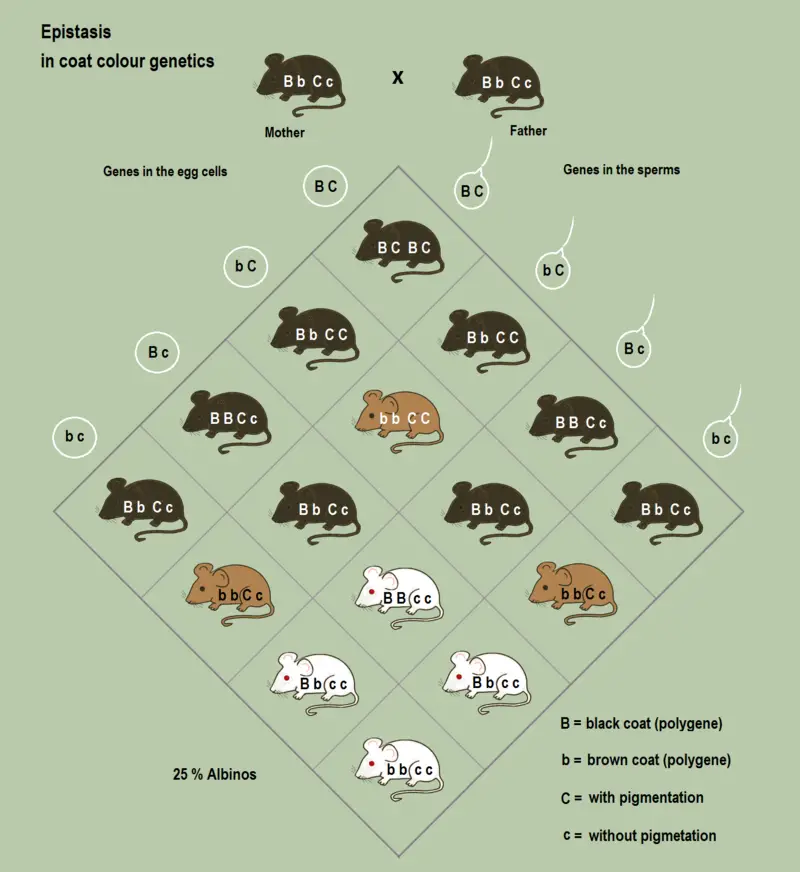
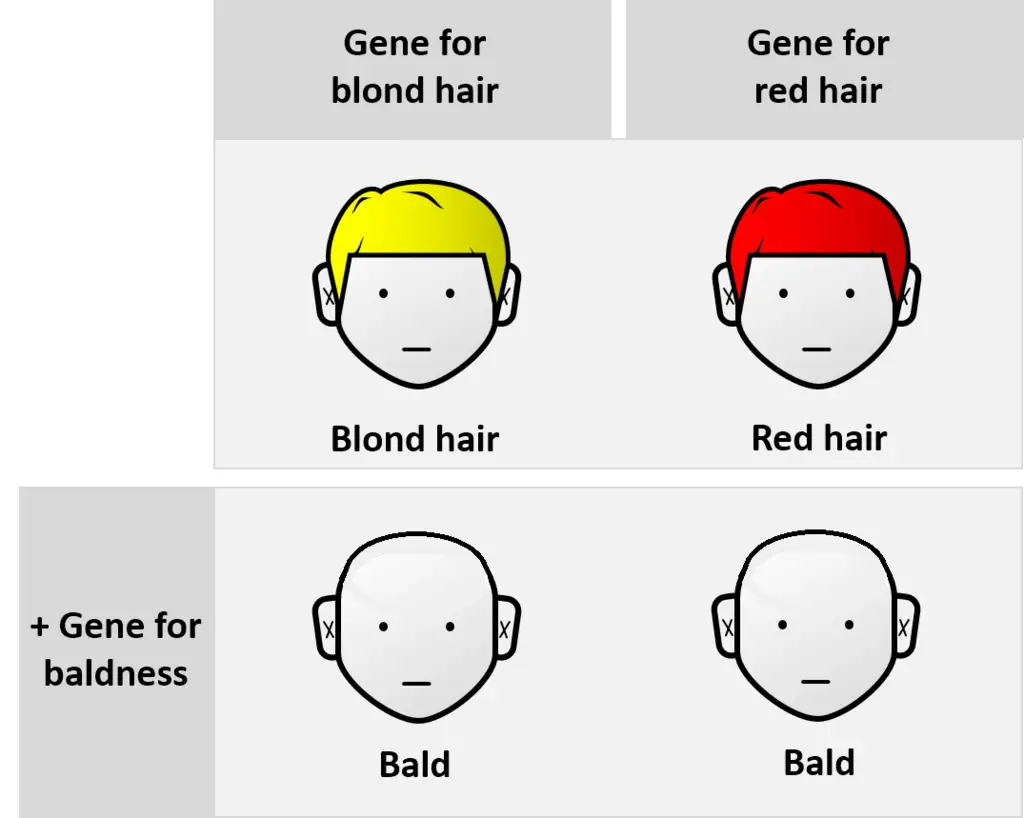
Similarities between Epistasis and Dominance
| Epistasis | Dominance |
| Epistasis genes always affect the same character. | Dominant gene also affects a particular character. |
| Epistasis involves nuclear genes. | Dominance also involves nuclear genes. |
Dissimilarities between Epistasis and Dominance
| Epistasis | Dominance |
| Epistasis refers to interaction of two or more genes. Thus it involves two or more loci. | Dominance refers to the interaction of two alleles of the same gene. Thus it involves single locus. |
| Epistasis may involve both homo and heterozygotes. Hence it is fixable in homozygotes. | Dominancealways refers to heterozygotes and, therefore, it is not fixable |
| Epistasis is of several types such as dominant, recessive, duplicate, etc. | Dominance is of three types, i.e., incomplete, complete and over dominance. |
| Epistasis modifies the normal dihybrid phenotypic ratios in F2. | Partial dominance alters the normal segregation ratio of 3 : 1 into 1:2:1. |
| Epistasis is also known as inter genie or inter-locus gene interaction. | Dominance is known as intragenic or intra-locus gene interaction. |
| Recessive gene can also exhibit masking effect. | Recessive gene can express only in homozygous condition. |
Implications of epistasis
Epistasis, the interaction between genes where one gene masks or modifies the expression of another, has several significant implications across various fields of genetics and medicine.
- Understanding Genetic Pathways
- Detailed Insights: Epistasis provides crucial information about the interactions and relationships between different genes. By studying these interactions, researchers can map out complex genetic pathways and understand how multiple genes contribute to a particular phenotype.
- Molecular Evolution of Infectious Diseases
- Disease Mechanisms: Epistatic interactions are integral to understanding the molecular evolution of infectious diseases such as HIV and Influenza. These interactions can influence how pathogens evolve, evade immune responses, and develop resistance to treatments.
- Antibiotic Resistance: The study of epistasis is also essential in understanding and combating the emergence of antibiotic resistance. By examining how different genetic mutations interact, researchers can identify new strategies for developing effective antibiotics.
- Oncology and Drug Discovery
- Cancer Research: In oncology, epistasis is leveraged to identify new drug targets and develop personalized cancer treatments. By understanding how different genes and their interactions affect cancer progression, scientists can design drugs that more specifically target the pathways involved in tumor development.
- Protein Structure and Function
- Protein Design: Epistatic patterns reveal valuable information about protein structure and interactions. This knowledge aids in the design of proteins with specific functions or properties, which is crucial for various applications in biotechnology and medicine.
- Personalized Medicine
- Predictive Medicine: Epistasis has significant implications for personalized medicine. By analyzing how individual genetic variations interact, it is possible to predict how a patient or pathogen will respond to specific treatments, leading to more tailored and effective therapeutic strategies.
Mindmap on Epistasis
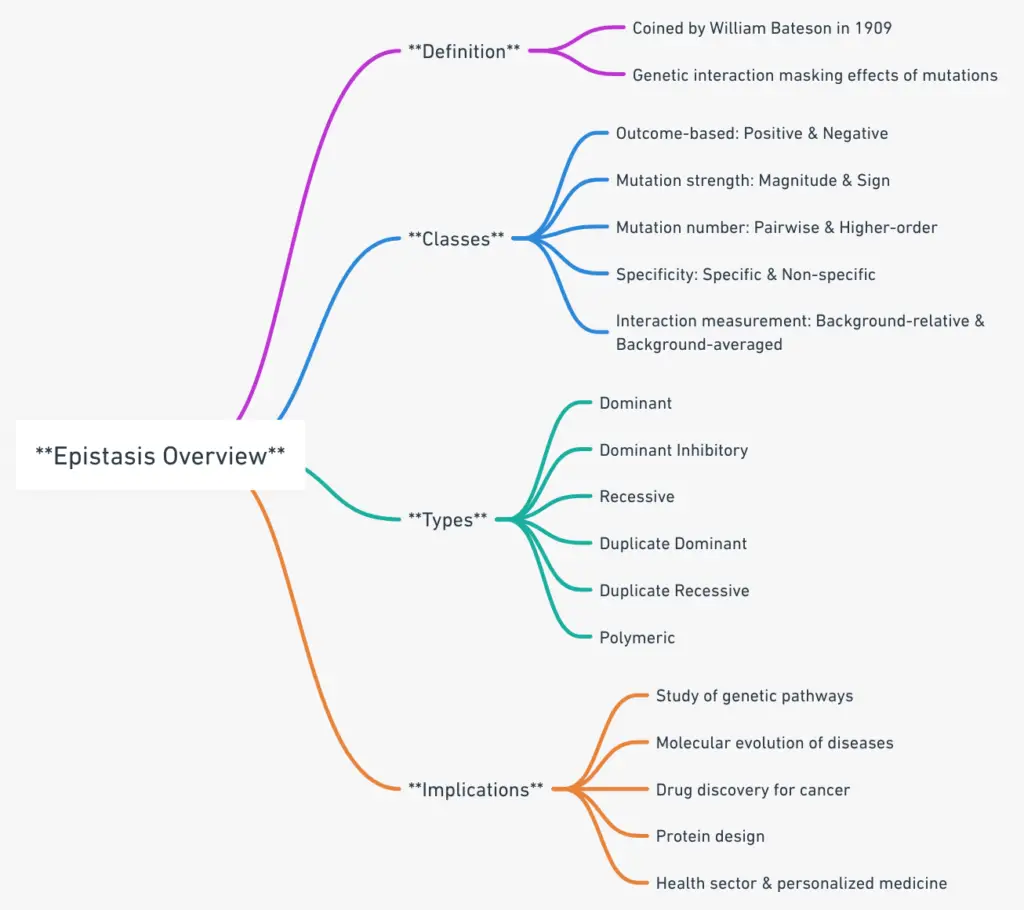
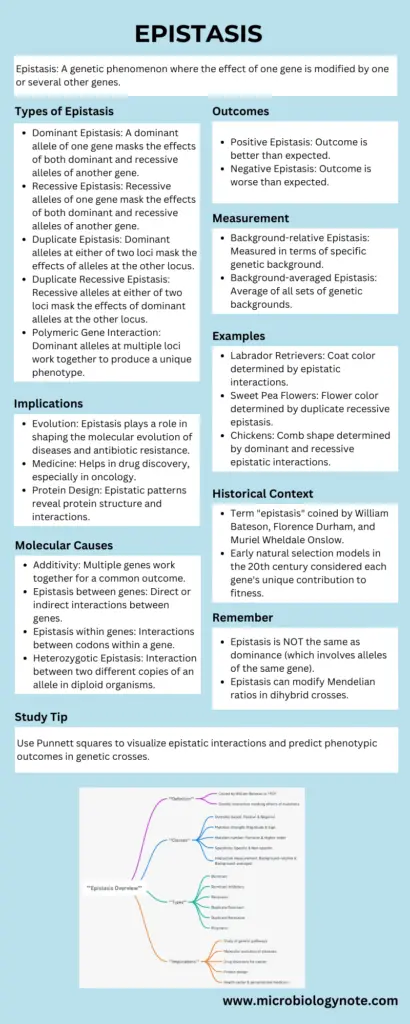
Latest research works on epistasis
- Rapid adaptation of recombining populations on tunable fitness landscapes
- Authors: Juan Li, André Amado, Claudia Bank
- Publication Year: 2023
- Overview: This study delves into how standing genetic variation affects polygenic adaptation in recombining populations. The research confirms that recombination hinders the movement of a population through rugged landscapes. It also highlights the interplay of recombination and epistasis in shaping the evolutionary trajectory of populations in a new environment.
- Link to the research
- Environment-dependent epistasis increases phenotypic diversity in gene regulatory networks
- Authors: Florian Baier, Florence Gauye, Ruben Perez-Carrasco, Joshua L. Payne, Yolanda Schaerli
- Publication Year: 2023
- Overview: This research focuses on how mutations to gene regulatory networks can either be maladaptive or a source of evolutionary novelty. The study uncovers a preponderance of epistasis that is environment-dependent, leading to greater phenotypic diversity than would be possible in the absence of such epistasis. The findings are discussed in the context of the evolution of hybrid incompatibilities and novelties.
- Link to the research
- Investigating epistasis in suicide ideation using multifactor dimensionality reduction: A population-based study from North India
- Authors: Vineet Chaudhary, Suchita Rawat, Ketaki Chandiok, Kallur Nava Saraswathy, Sneha Yadav
- Publication Year: 2023
- Overview: This study aims to understand the association of suicide ideation (SI) with selected gene polymorphisms and their epistatic interactions using Multifactor Dimensionality Reduction (MDR) analysis. The research was conducted among individuals from Haryana, North India. The study found that the AA genotype of KIAA0319 rs2760157 was significantly higher in ideators, but SI was not independently associated with any SNPs. The role of synergistic epistasis in SI should be explored in future studies.
- Link to the research
Practice Quiz
[mcq_display ids=”58183,58184,58185,58186,58187,58188,58189,58190,58191,58192″]
FAQ
What is epistasis?
Epistasis is a genetic phenomenon where the effect of one gene (the epistatic gene) masks or modifies the effect of another gene (the hypostatic gene).
How is epistasis different from dominance?
While both involve masking effects, dominance occurs when one allele masks the effect of another allele within the same gene. Epistasis, on the other hand, involves the interaction between two different genes.
What causes epistasis at the molecular level?
Epistasis can arise due to various molecular interactions, such as when genes are part of the same metabolic pathway, when proteins encoded by genes directly interact, or when mutations in one gene alter the function of another.
What are the main types of epistasis?
The primary types include dominant, recessive, duplicate, duplicate recessive, and polymeric gene interaction epistasis.
Can you provide an example of epistasis in animals?
Certainly! The coat color of Labrador retrievers is a classic example. The expression of the black or brown coat color gene can be masked by another gene, resulting in yellow Labradors.
How does epistasis affect Mendelian inheritance ratios?
Epistasis can modify the expected Mendelian ratios. For instance, instead of the dihybrid 9:3:3:1 ratio, due to epistatic interactions, we might observe ratios like 9:7, 12:3:1, or 15:1.
Why is understanding epistasis important in genetics and medicine?
Epistasis plays a crucial role in understanding the complexity of genetic traits, the evolution of diseases, and the development of drug resistance. It also aids in drug discovery, especially in fields like oncology.
Is epistasis common in nature?
Yes, epistasis is quite common. Given the complexity of genetic networks and pathways, genes often do not operate in isolation but interact with multiple other genes, leading to epistatic effects.
How can epistasis be detected or studied?
Epistasis can be studied using genetic crosses, where deviations from expected Mendelian ratios can indicate epistatic interactions. Additionally, molecular biology techniques and computational models can help in understanding the underlying mechanisms.
Are there any implications of epistasis in evolutionary biology?
Absolutely! Epistasis can influence the trajectory of evolutionary changes. For instance, if two beneficial mutations have a negative epistatic interaction, it might be less likely for both mutations to become fixed in a population.
- Phillips, P. Epistasis — the essential role of gene interactions in the structure and evolution of genetic systems. Nat Rev Genet 9, 855–867 (2008). https://doi.org/10.1038/nrg2452
- Churchill, G.A. (2013). Brenner’s Encyclopedia of Genetics || Epistasis. , (), 505–507. doi:10.1016/b978-0-12-374984-0.00482-4
- Churchill, G.A. (2001). Encyclopedia of Genetics || Epistasis. , (), 638–641. doi:10.1006/rwgn.2001.0417
- Heather J. Cordell, Epistasis: what it means, what it doesn’t mean, and statistical methods to detect it in humans, Human Molecular Genetics, Volume 11, Issue 20, 1 October 2002, Pages 2463–2468,
- https://doi.org/10.1093/hmg/11.20.2463
- https://www.genome.gov/genetics-glossary/Epistasis
- https://bio.libretexts.org/Bookshelves/Introductory_and_General_Biology/Book%3A_General_Biology_(Boundless)/12%3A_Mendel’s_Experiments_and_Heredity/12.3%3A_Laws_of_Inheritance/12.3F%3A_Epistasis
- https://www.pw.live/exams/neet/epistasis/
- https://www.biologyonline.com/dictionary/epistasis
- https://www.slideshare.net/rajpalchoudharyjat/epistasis-and-its-different-types
- http://www.cs.cmu.edu/~sssykim/teaching/s13/slides/Lecture_epistasis.pdf
- https://science.umd.edu/classroom/bsci410-liu/BSCI410-S09/Lecture5.pdf
- https://cupdf.com/document/epistasis-56947769b4e47.html
- http://www.surendranathcollege.org/new/upload/DIPASREE_ROYCHOWDHURYEPISTASIS%20class%2012020-04-09DRC-%20Epistatis-converted.pdf
- https://www.biologydiscussion.com/genetics/gene-interactions/epistasis-and-dominance-similarities-and-dissimilarities/37795
- https://www.biologydiscussion.com/genetics/gene-interactions/top-6-types-of-epistasis-gene-interaction/37818
- https://courses.lumenlearning.com/wm-biology1/chapter/reading-epistasis-2/
- Text Highlighting: Select any text in the post content to highlight it
- Text Annotation: Select text and add comments with annotations
- Comment Management: Edit or delete your own comments
- Highlight Management: Remove your own highlights
How to use: Simply select any text in the post content above, and you'll see annotation options. Login here or create an account to get started.